Lithography
The
beginnings of Lithography – ‘Polyautographs’
(Pen
Lithographs)
The
Munich actor and playright, Alois Senefelder
(1771-1834) was seeking an economical method
of duplicating plays and sheet music when
he discovered lithography (from the Greek lithos and
graphos, 'stone
writing'), a method of ‘Chemical
Printing’,
in 1798. His system was based on exploiting
the simple chemical fact of the mutual
repellence of grease and water. Senefelder
(see illustration below) quickly
appreciated that the technique would be
equally ideal for creating artists’ printed
drawings.
While
briefly in partnership with the music publisher
Johann Anton André, Senefelder visited
London to acquire the English patent, though
he sold out to André and it was
André’s son, Philipp André,
who became the patentee.
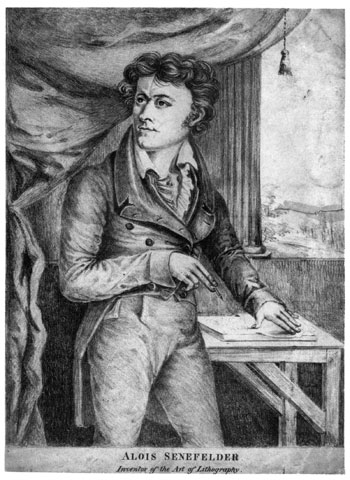 |
Alois
Senefelder, working on a lithographic
stone. An anonymous early
19th century
crayon lithograph. |
|
André was
especially interested in the technique
as a new graphic art and sent the necessary
materials to artists inviting them to experiment.
In 1803 he published in London the first
ever artists’ original
lithographs, under the title SPECIMENS
OF POLYAUTOGRAPHY. The initial twelve
contributing artists included Benjamin
West, the president of the Royal Academy,
Henry Fuseli, James Barry and Thomas Barker
(see above right).
These
rare English incunabula of lithography
were all drawn with the pen. The artist
drew on a porous limestone block with pen
and greasy lithographic ink, known later
as tusche, composed of wax, soap and lampblack.
When the treated stone was inked up for
printing the ink adhered only to the areas
of the original greasy drawing and the
resulting impression bore a remarkable
resemblance to an original pen drawing.
After
1810, later artists have only rarely used
the pen for lithography. Their productions
are usually termed ‘pen lithographs’ to
distinguish them from the more usual crayon
lithography, 'polyautograph' being reserved
for the very early examples.
Crayon
Lithography
It
was on his London visit in 1800 that Senefelder
perfected the chalk (or crayon) manner of
lithography, which has subsequently had
the largest following amongst artists.
In crayon lithography, the artist draws
with a greasy lithographic crayon and the
resulting printed impressions have the
character of chalk drawings. Depending
on the pressure and thickness of his line
in drawing with the crayon the artist can
achieve a range of tones from silvery grey
to intense black. ‘White’ areas
are either undrawn or created with the
scraper (see right, the illustration
of Gavarni’s self-portrait in his studio). Where the greasy drawing is scraped
away the ink will not adhere in the printing. For
greater range of tone artists sometimes
work with crayon and tusche together.
Lithotint
Another
variation, also first adopted by Senefelder
for ‘tinted’ lithography and
later called lithotint was adapted by Whistler
to a tonal monochrome technique. In lithotint
the artist draws with brush and tusche
washes variously diluted with water according
to the desired tonal effect (see to
the right, below, Lunois’ brush lithograph
of “La Guitariste”). Lithography
is unique in this versatility of being
both a linear and a tonal technique.
Lithographic Process and Printing
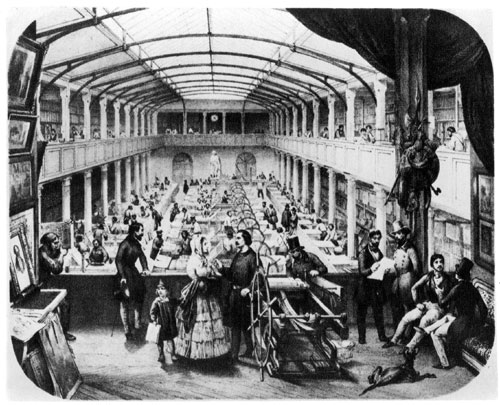
"Imprimerie
Lemercier, rue de Seine, Paris". Lithograph,
c1845
One of the leading lithographic printing
firms in 19th century France.
Senefelder
also invented the lithographic press for
printing lithographs (see illustration
right).
Preparing lithographic stones for printing
is a complex and laborious process, which
is generally carried out by a professional
lithographic printer working in close collaboration
with the artist. The lithographic matrix
traditionally was limestone, from the Solenhofen
district in Bavaria, near Munich, which
was particularly porous and had an affinity
for grease. The lithographic crayon allows
the artist to draw freely and readily on
the stone (see right). The greasy drawing
material seeps into the pores of the stone.
The stone is painted with gum-etch (gum arabic
dissolved in water with nitric acid) to
increase the porosity of the undrawn areas
so they hold water when dampened with a
sponge, whereas it is rejected by those
areas which have absorbed the greasy drawing.
Conversely, these areas accept the ink
when it is rolled over while it is repelled
by the damp areas. Paper is laid over the
stone and the image is transferred as the
stone is moved laterally through the press
beneath a scraper or roller.
The development and spread of Lithography
After
the initial period of experimentation lithography
was slow to be taken up by artists in England
(an early exception is James Ward). From
the 1830’s it increasingly superseded
aquatint for topography and decorative
prints but it was not till the 1890’s
that British artists once more took it
up as an original expression, which was
fostered and promoted by the founding of
the Senefelder Club in 1908.
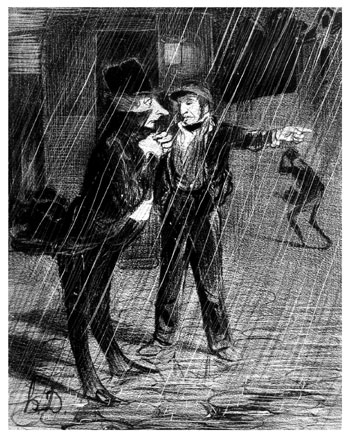
Honoré Daumier
(1808–1879): "Comment à Chaillot!…"
Lithograph
1839. (240 x 189 mm)
An
unhappy customer on a dark rainy night
has taken the last ‘bus’
in
the wrong direction and it being midnight
the service is finished.
Daumier
has scratched into the surface of the
stone to create the
‘white’ lines
of the rain.
French
artists were more receptive to the new
technique. The rich blacks, the tonal
subtleties and the spontaneity of drawing
particularly appealed to the great Romantic
artists such as Géricault and Delacroix.
Goya, in exile in Bordeaux at the end of
his life took up lithography in 1825 at
the age of seventy-nine. Books and political
periodicals exploited lithography for original
illustrations and caricatures (see
Daumier immediately above, and Gavarni, above
right).
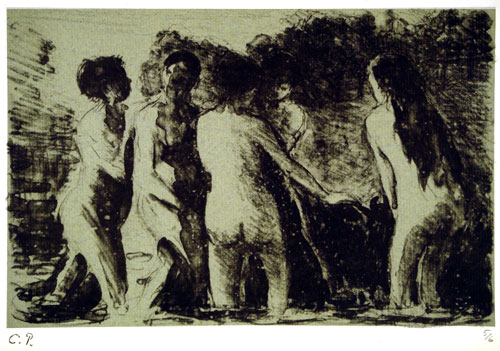
Camille
Pissarro (1830–1903): "Théorie
de Baigneuses".
Lithograph, c1894–97. (130
x 200 mm)
(This
example from the posthumous edition of
six, printed on blue-green
paper. Stamped
with the artist’s initials and numbered
in pencil.)
From
the 1850’s there is a hiatus, followed
by a flowering throughout Europe in the
1890’s, of lithography for artists’ original
prints, particularly as a colour technique.
The technique has continued to be popular
with modern artists such as Matisse (see
right) and Picasso.
Transfer Lithography
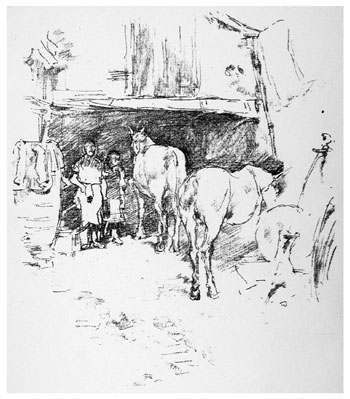 |
James
McNeill Whistler (1834–1903)
"The Smith’s Yard, Lyme Regis".
Transfer lithograph, 1895
Issued in ‘The Studio’ 1897. (200 x 140 mm) |
|
Lithographic
stones being unwieldy to handle and nigh
on impossible to take outside to work directly
on a motif from nature, artists sometimes
made use of lithographic transfer paper
on which to make their lithographic drawings.
Senefelder had also instigated this method
at the inception of lithography.
Lithographic
transfer paper has the advantage that the
image is reversed in being transferred
to the stone so that the print reads in
the same direction as the original drawing;
however the impressions are generally more
delicate and with less tonal contrast than
is possible when the artists draws directly
onto the stone. Compare the Whistler and
Daumier lithographs above: Daumier
drew onto the stone; Whistler used transfer
paper.
Transfer
lithographs were the cause of a celebrated
law suit in 1897 between Sickert and Joseph
Pennell. Sickert’s
assertion that Pennell’s prints were
not original lithographs because they were
drawn on transfer paper, was thrown out
of court. |